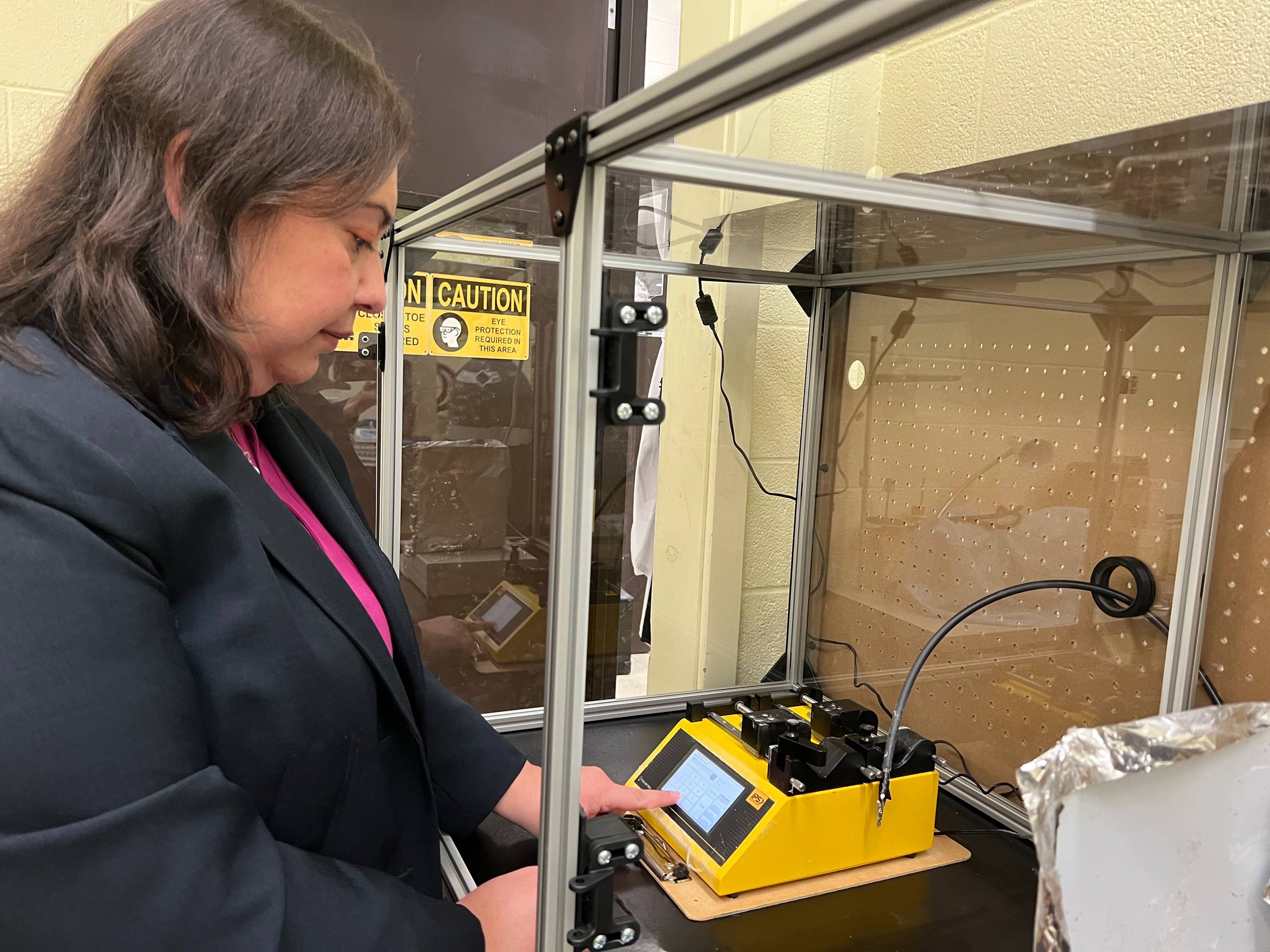Every year, there are roughly 450,000 burn wounds that require clinical care throughout the United States. Of those, more than 3,500 people are fatally injured.
An interdisciplinary team of Wichita State University researchers is working to revolutionize burn-wound care with a scaffolding system that prevents infection and promotes healing.
Dr. Eylem Asmatulu, associate professor of mechanical engineering, recently received a $25,000 grant from KTEC Holdings to develop a “novel three-layered multifunctional bio-scaffolding for localized and fast burn wound treatments.”
“We saw the burn-wound market as a huge growth opportunity, and we can contribute to this with a better product and help people with something that can treat different sizes of burns on any part of the body,” Asmatulu said.
Current commercially available burn treatments include gels, pads and ointments.
“Those are temporary solutions for the burn,” Asmatulu said. “We can produce something that can keep the wound clean, and it has a drug-release mechanism. It will release the drug through the skin and have a patient heal in a quicker, cleaner way.”
For this project, Asmatulu is working with Dr. Shang-You Yang, research associate professor of biology; Dr. Jeremy Patterson, dean of the WSU’s College of Innovation and Design and executive director of Innovation and New Ventures; and Dr. Ahmed Ijaola, who earned his doctorate in mechanical engineering from Wichita State in 2021.
The scaffolding system includes three layers working in concert to prevent contamination and encourage swift healing.
- The superhydrophobic layer is the topmost layer of the wound dressing and is made from recycled Styrofoam. This layer is water-repellent and has self-cleaning capabilities.
- A hydrogel forms the middle layer of the dressing, and it is loaded with bioactive component needed for wound healing. It’s fabricated from polymers, nanoparticles, bovine serum albumin and aloe vera.
- The hydrophilic layer is the bottom layer, which comes in direct contact with wound, and contains silver nanoparticles to destroy bacteria such as E. coli and S. aureus, which are commonly found at wound sites and are known to delay wound healing process.
Yang said the current products on the market are insufficient for treating second- and third-degree burns.
“It’s not like a gel or a burn pad,” he said. “The current marketable products can easily introduce contamination from the environment. We use particles that can prevent infections.”
The most critical time for burn-wound patients is within the first 48 hours after the injury occurs, Yang said. During the first two days is “the time when tissue degrades, and bacteria is introduced to make the wound worse.”
Additionally, current burn treatments need to be changed frequently to ensure the wound stays clean; but each time a burn wound is uncovered, there’s a possibility that bacteria could be introduced into the wound. However, with the scaffolding system, burn coverings do not have to be changed as frequently, lowering the risk of infection.
Ijaola, who currently works as a senior process engineer for Intel in Oregon, worked closely with Yang to understand the biological science of burn wounds.
“As a material scientist, I studied the surface morphology, surface chemistry, thermal degradation, and wetability of the fabricated superhydrophobic and hydrophilic layer,” Ijaola said. “In addition to this, I did bacterial culture and biocompatibility studies under the tutelage of Dr. Yang.”
Asmatulu said Yang guided the team on the biological compatibility of the materials used in the layers.
“He trained the students and taught them everything in terms of the biological studies and testing the materials we produced,” Asmatulu said. “He helped us understand whether the material is toxic or safe for the human body.”
The burn wound scaffolding system is still in the early research stages, but the team is optimistic about the possibilities.
“We have been collaborating on projects related to electrospun nanofiber technology for a number of years, starting with basic applications like masks for COVID. As we advance the technology, we’ve started to narrow its market fit,” Patterson said. “This interdisciplinary team has a lot of energy and drive to see the research get to the point where it may solve or assist a healthcare issue and have a positive impact on society.”
About Wichita State University
Wichita State University is Kansas' only urban public research university, enrolling almost 22,000 students between its main campus and WSU Tech, including students from every state in the U.S. and more than 100 countries. Wichita State and WSU Tech are recognized for being student centered and innovation driven.
Located in the largest city in the state with one of the highest concentrations in the United States of jobs involving science, technology, engineering and math (STEM), Wichita State University provides uniquely distinctive and innovative pathways of applied learning, applied research and career opportunities for all of our students.
The Innovation Campus, which is a physical extension of the Wichita State University main campus, is one of the nation’s largest and fastest-growing research/innovation parks, encompassing over 120 acres and is home to a number of global companies and organizations.
For more information, follow us on Twitter at www.twitter.com/wichitastate and Facebook at www.facebook.com/wichita.state.


 Sara Tank Ornelas
Sara Tank Ornelas